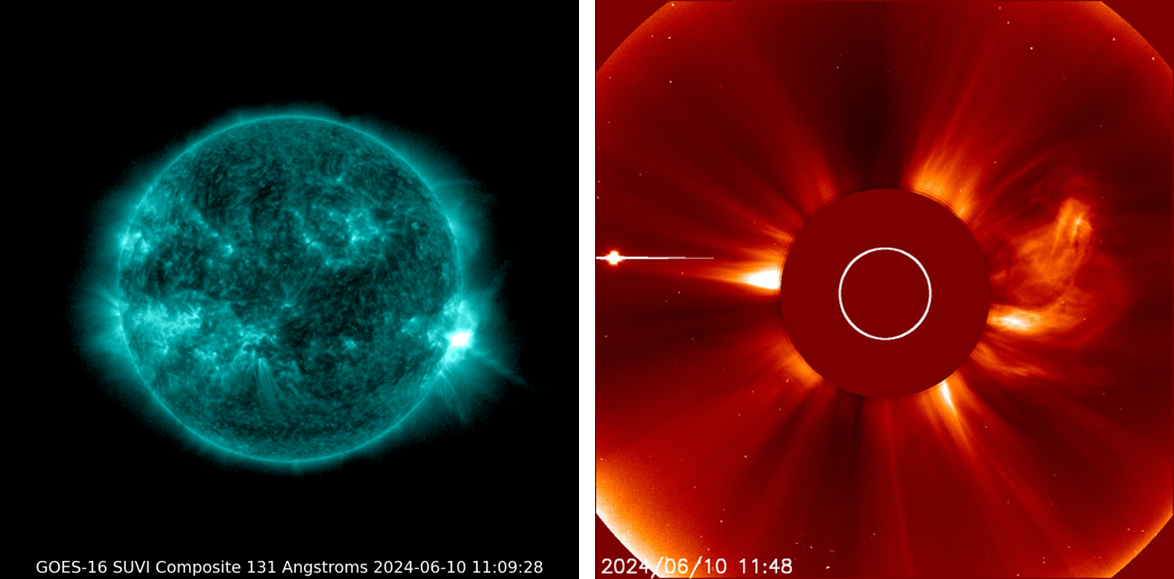Please scroll down to the end of this newsflash for updates.
NOAA 3664 was the source of intense solar flaring during the first half of May, and also of the coronal mass ejection (CME) that eventually resulted in one of the strongest geomagnetic storms in decades (10-11 May), as discussed at length in this STCE newsitem. Though, two weeks later, this region is still behind the Sun's southeast limb, it already managed to produced an X2.8 flare peaking early on 27 May at 07:08UTC (GOES).
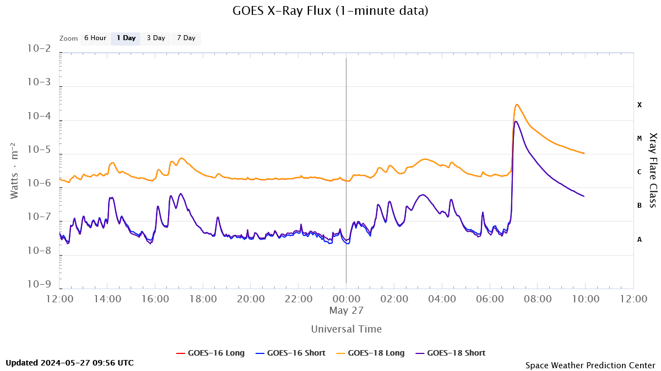
This returning active region obviously has not gotten a number by NOAA/SWPC yet, but is expected to round the solar limb over the next 24 hours. The clips underneath show the eruption in extreme ultraviolet (GOES) at temperatures of around 80.000 degrees (SUVI 304; left) and of several million degrees (SUVI 131; right). The blooming and diffraction patterns that can be seen especially in the GOES/SUVI 131 images are instrumental (more information is in Note 1 of this STCE newsitem). The post-eruption coronal loops were also nicely imaged by the SIDC/USET solar telescopes in H-alpha (red line in the solar spectrum) revealing the delicate arches protruding from behind the solar limb. (Combination GOES/SUVI 131 and 304: still ; clip).
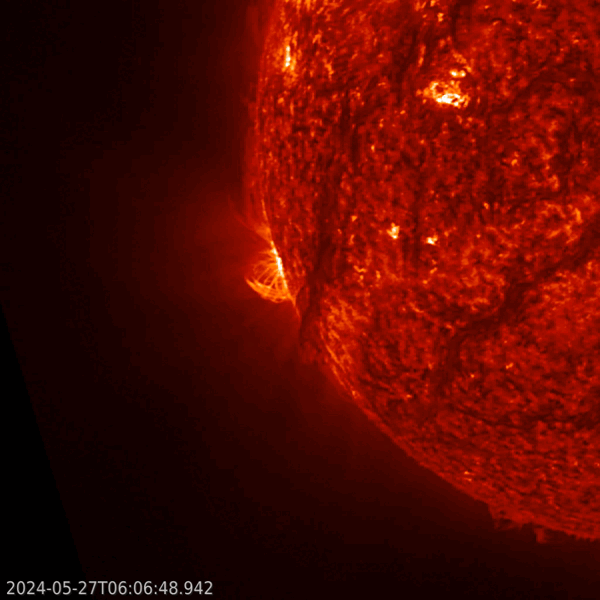 |
 |
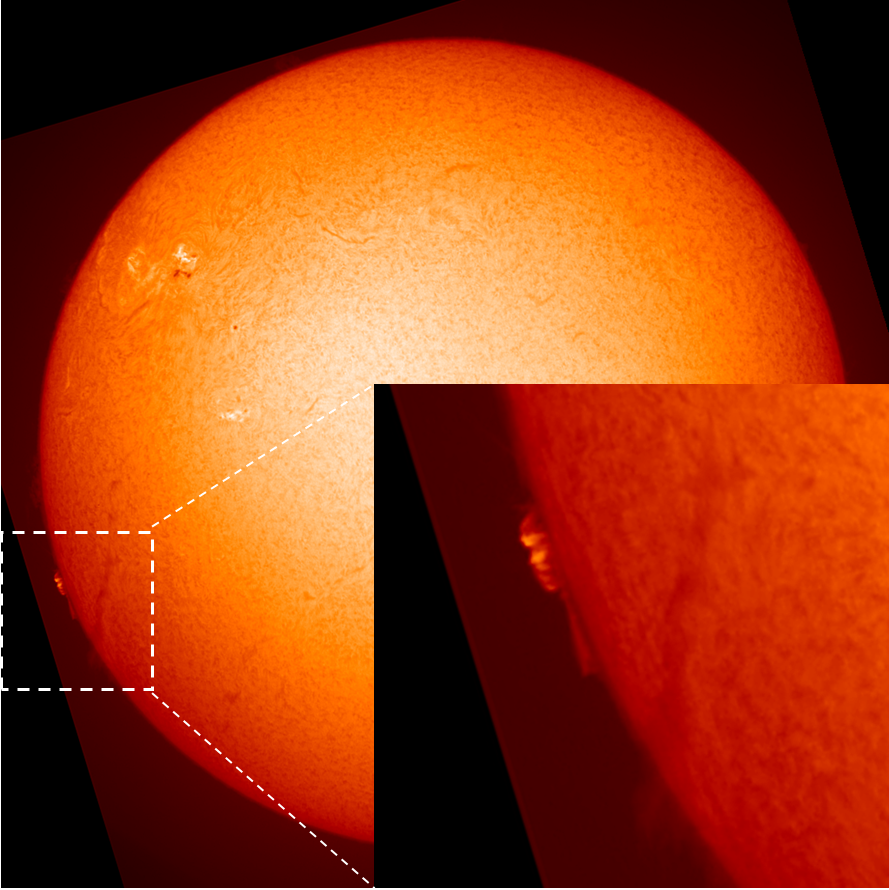
The features seen in the above imagery already suggest that a CME was associated with this eruption, and sure enough the STEREO-A/COR 2 coronagraph shows a fast and solid CME billowing away from the Sun. In view of the source location and the CME's width, the CME does not have an earth-directed component. The greater than 10 MeV proton flux (GOES) has remained at background levels so far.
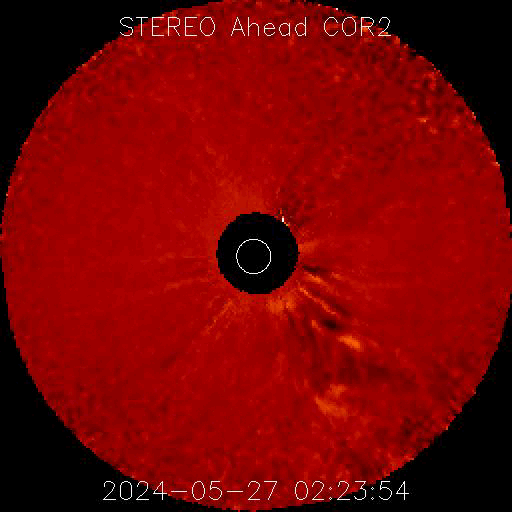
High Frequency (HF) communications may have been disturbed over the daylight side of the Earth (D-RAP ; map underneath). Advisories for disturbed HF Com have been sent to the civil aviation by PECASUS. Several magnetometer stations on the daylight side of the Earth, including Dourbes Geophysical Center, registered a small solar flare effect (SFE) of 5-15 nT associated with this flare (Intermagnet (BGS)). An SFE happens when one or more components of the magnetic field strength show a spike around the time of the flare's peak due to ionospheric enhancement by the flare's x-ray and (E)UV radiation (also known as a "magnetic crochet"). The strength of the SFE (in nT) as measured by a few of these stations has been overlaid on the D-RAP map. For example, the SFE measured in Dourbes, Belgium was 6 nT, whereas in Hyderabad, India it was at 12 nT.
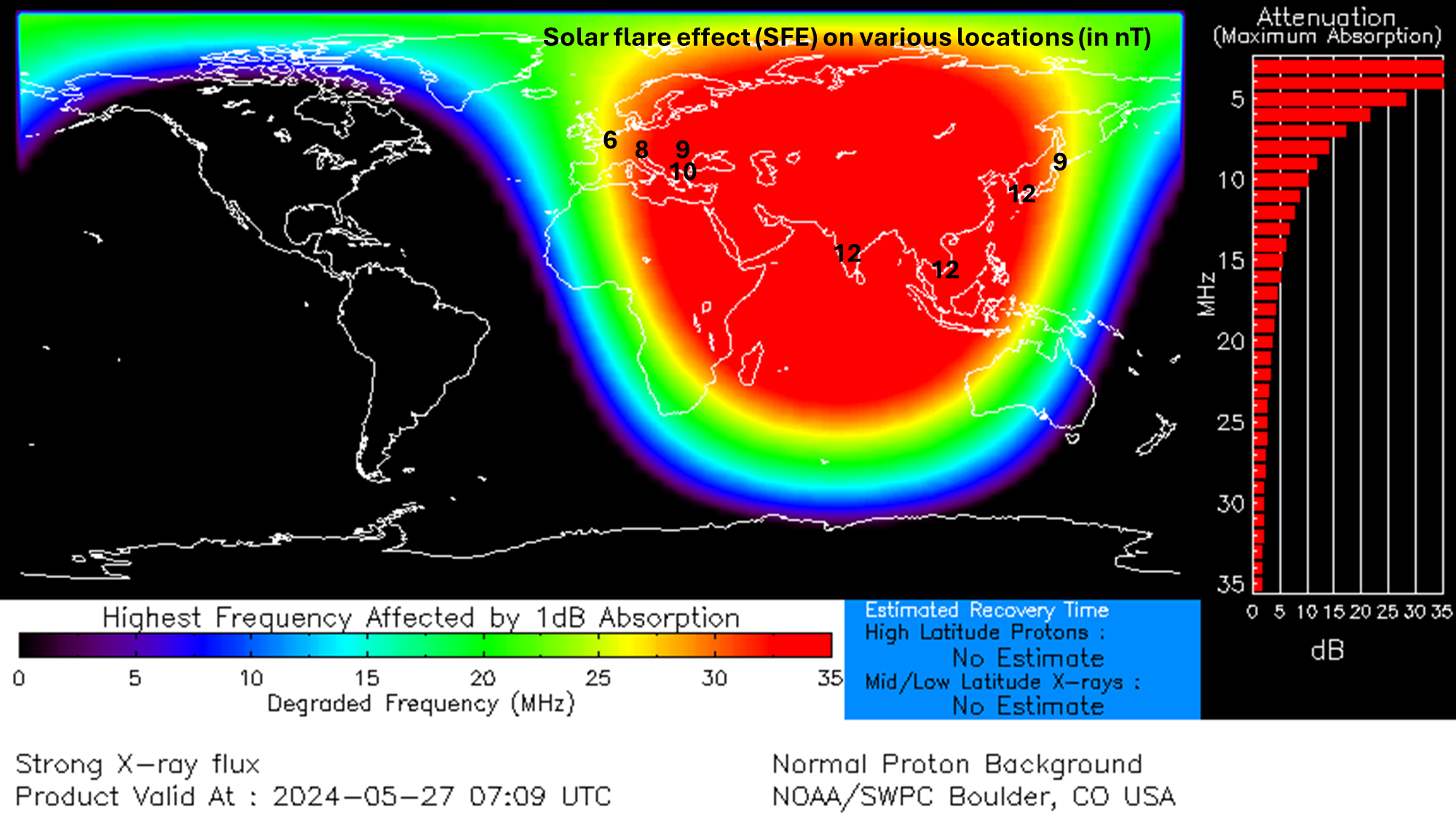
Radio bursts were relatively weak but were registered over all frequencies observed by the NOAA/USAF network. The Humain Radioastronomy Station recorded clear Type II and Type III radio bursts (annotated radio spectrogram underneath). Over the next few days, as the active sunspot region has rotated over the limb, it will become clear whether we may expect further strong flaring from this group. At any rate, it made an entry in style.
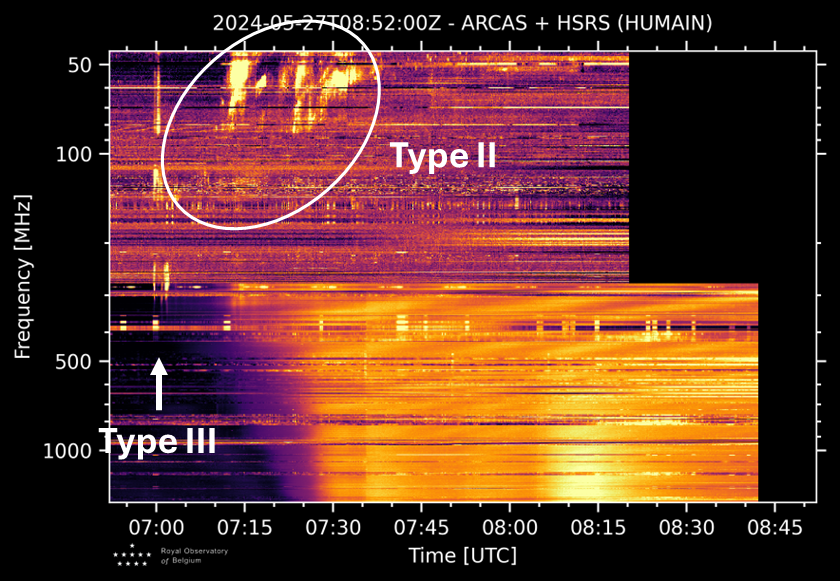
UPDATE 29 May at 16:45UTC - As expected, NOAA 3697 (old active region NOAA 3664) produced another X-class flare. This long duration X1.4 flare peaked on 29 May at 14:37UTC. A Type II radio burst was observed by the Humain Radioastronomy Station (radio spectrogram underneath) and Owens Valley (OVSA). Preliminary coronagraphic images from STEREO-A around 15:30UTC show a solid CME which seems wide enough to deliver a glancing blow to the earth environment later this week. The SIDC forecaster is now standing by for further coronagraphic imagery (SOHO) to finetune the direction of propagation and the time of arrival (if any). For sure, as the bulk of the CME is directed away from the Earth, any geomagnetic activity is not expected to be strong. Further X-class flaring from NOAA 3697 can be expected over the coming days, with an increasing chance of an earth-directed CME as the region rotates further over the solar disk.
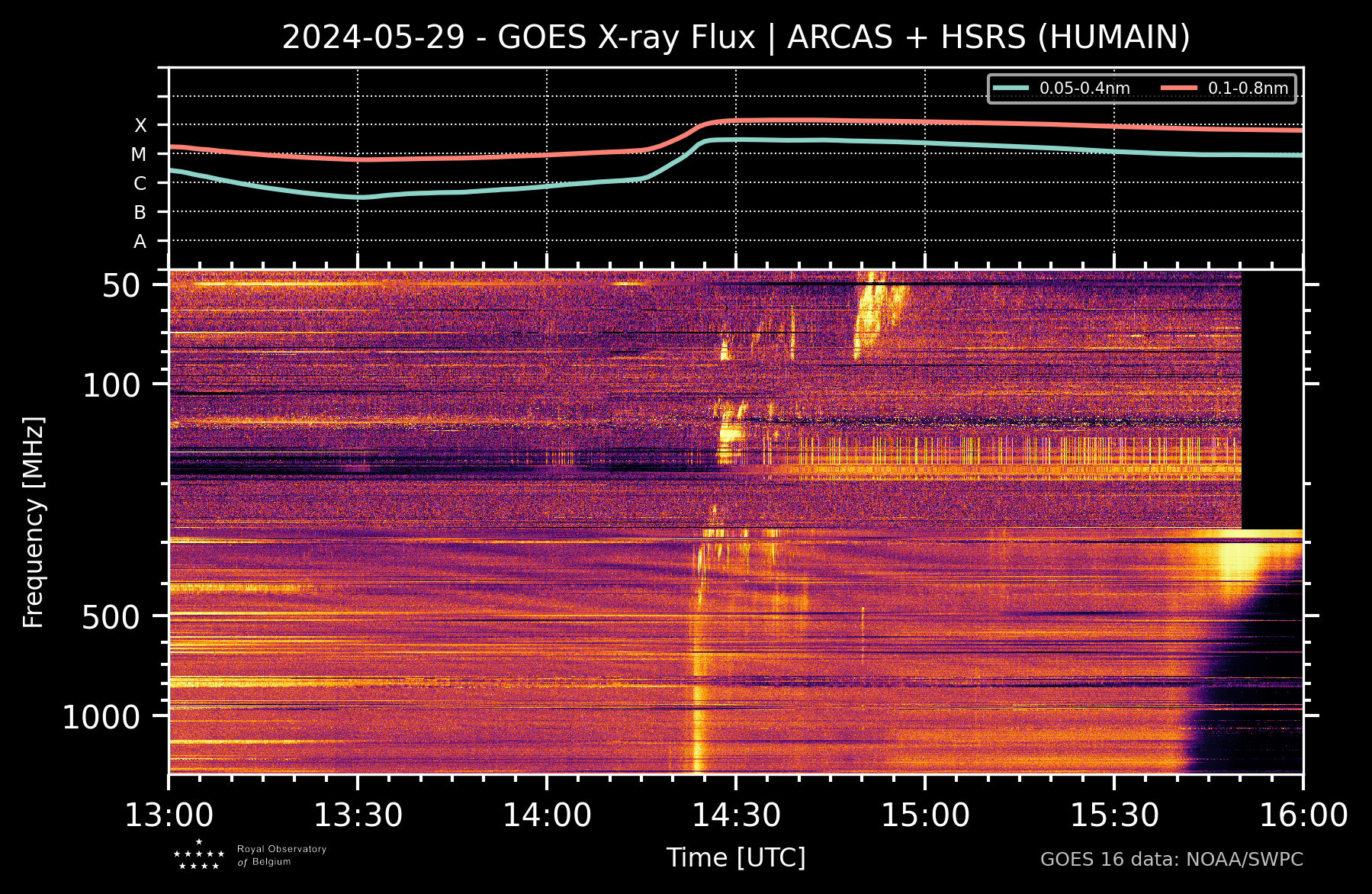
Radio bursts were relatively weak but were registered over most frequencies observed by the NOAA/USAF network., including at 2.8 GHz where the daily solar radio flux is measured. High Frequency (HF) communications may have been disturbed over the daylight side of the Earth (D-RAP ; map underneath). Advisories for disturbed HF Com have been sent to the civil aviation by PECASUS. Several magnetometer stations on the daylight side of the Earth, such as on Tenerife and in Algeria registered a small solar flare effect (SFE) of around 10 nT associated with this flare (Intermagnet (BGS)). An SFE happens when one or more components of the magnetic field strength show a spike around the time of the flare's peak due to ionospheric enhancement by the flare's x-ray and (E)UV radiation (also known as a "magnetic crochet").
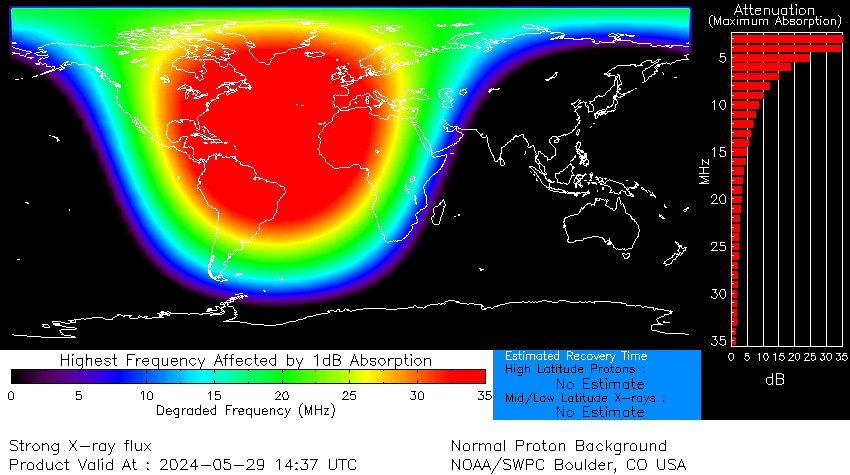
UPDATE 01 Jun at 06:30UTC - As expected, NOAA 3697 (old active region NOAA 3664) produced another X-class flare. This X1.1 flare peaked on 31 May at 22:03UTC (GOES). No Type II radio burst nor coronal dimming (Solar Demon) was observed. Preliminary coronagraphic images from STEREO-A show no associated CME. This is in sharp contrast to the 2 previous X-class events from this active region. The 3 flares occurred within the same time interval of each other (about 2 days and 8 hours ; see graph underneath), but it is unlikely NOAA 3697 will produce another X-class event after exactly this time interval again in view of the very different outcome (no CME) of the latest X-class event (see this STCE newsitem on homologous flares). Nonetheless, as the sunspot group still hosts a strong delta magnetic structure (see annotated SDO image below), further X-class flaring from NOAA 3697 can be expected over the coming days, with still a chance of an earth-directed CME as the region rotates further over the solar disk. Radio bursts were relatively weak and observed over the higher frequency range (2 GHz and above) by the NOAA/USAF network, including at 2.8 GHz where the daily solar radio flux is measured. High Frequency (HF) communications may have been disturbed over the daylight side of the Earth (D-RAP), in particular over the USA, Mexico and the Pacific Ocean. Advisories for disturbed HF Com have been sent to the civil aviation by PECASUS.
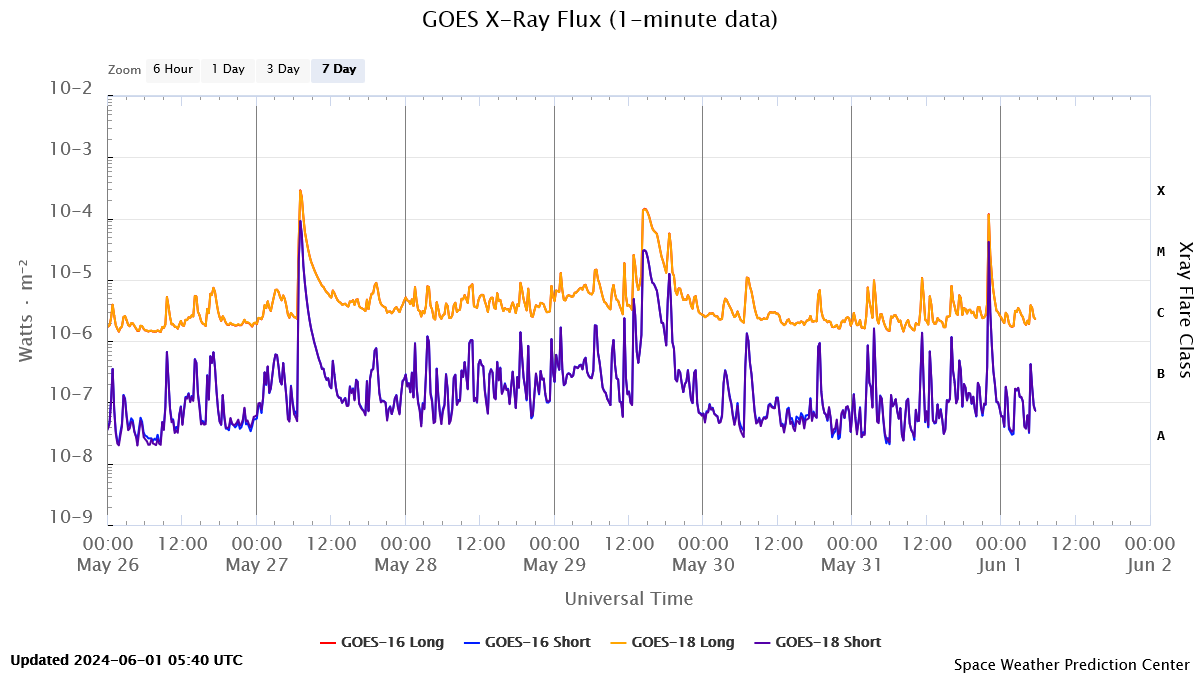

UPDATE 01 Jun at 17:00UTC - Living up to the expectations, NOAA 3697 (old active region NOAA 3664) produced a second X-class flare in less than 24 hours. The X1.4 flare peaked on 1 June at 08:48UTC (GOES). No Type II radio burst (Humain ; spectrogram underneath) nor coronal dimming (Solar Demon) was observed. Preliminary coronagraphic images from STEREO-A show no associated CME, similar to the X-class event of yesterday. As the sunspot group still hosts a strong delta magnetic structure, further X-class flaring from NOAA 3697 can be expected over the coming days, with still a chance of an earth-directed CME as the region rotates further over the solar disk. Several magnetometer stations on the daylight side of the Earth registered a small solar flare effect (SFE) of 10-12 nT associated with this flare (Intermagnet (BGS)). Radio bursts were relatively weak and observed over the higher frequency range (2 GHz and above) by the NOAA/USAF network, including at 2.8 GHz where the daily solar radio flux is measured. High Frequency (HF) communications may have been disturbed over the daylight side of the Earth (D-RAP), in particular over the Europe, Africa, the Arabian peninsula, Russia, Indi and China. Advisories for disturbed HF Com have been sent to the civil aviation by PECASUS.
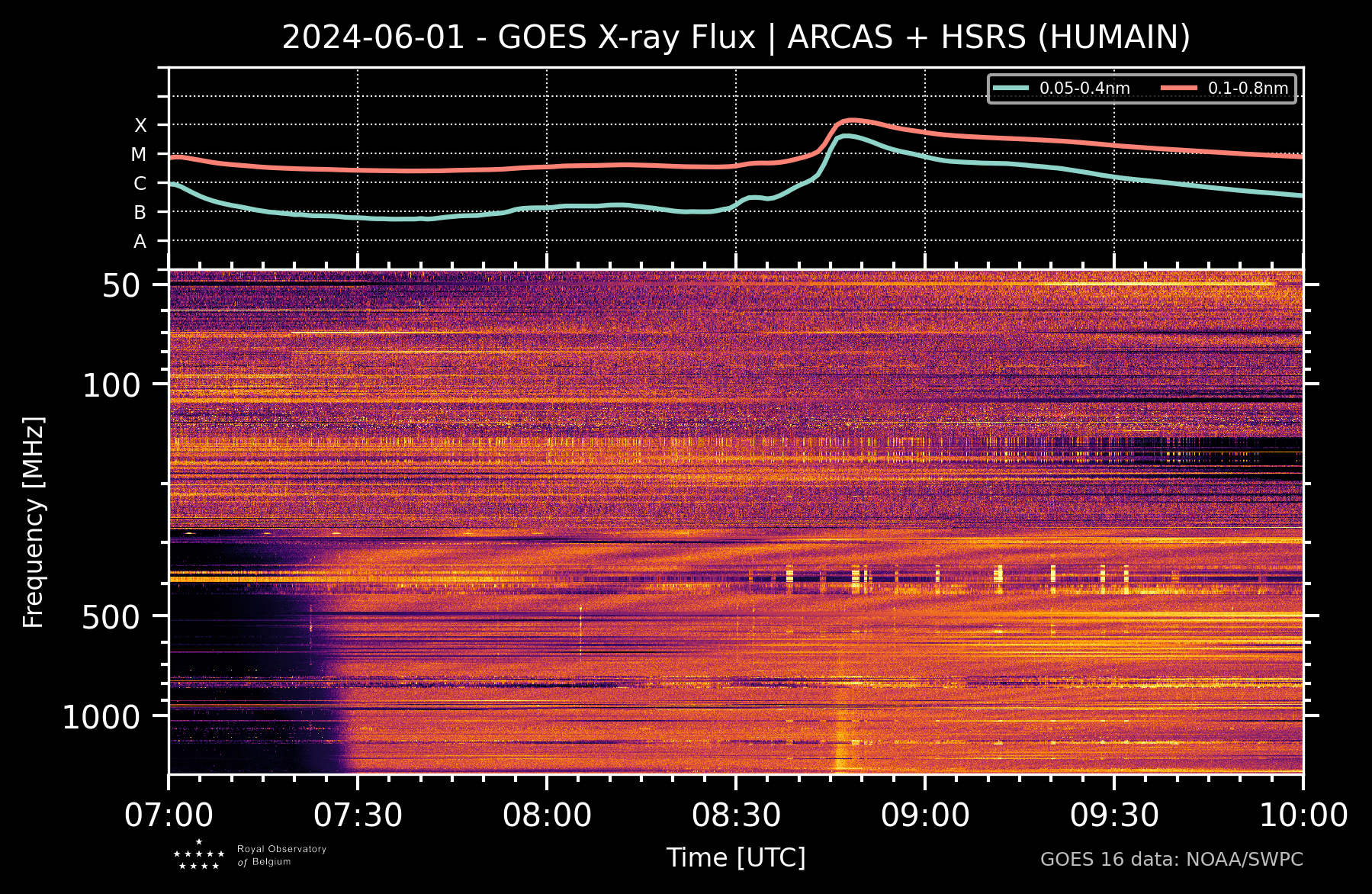
UPDATE 01 Jun at 20:00UTC - No two without three. NOAA 3697 has just produced its third X-class flare in less than 24 hours. The X1.0 flare peaked on 1 June at 18:36UTC (GOES). A weak Type II radio burst (Owens Valley ; spectrogram underneath) and some small coronal dimming (Solar Demon) has been observed. Preliminary coronagraphic images from STEREO-A seem to show a faint CME. The SIDC forecaster is now standing by for further coronagraphic imagery (SOHO) to finetune the direction of propagation and the time of arrival (if any). As the sunspot group still hosts a strong delta magnetic structure, further X-class flaring from NOAA 3697 can be expected over the coming days, with a chance of an earth-directed CME as the region rotates further over the solar disk. Some magnetometer stations on the daylight side of the Earth registered a small solar flare effect (SFE) of a few nT associated with this flare (Intermagnet (BGS)). The proton flux has remained at background levels (GOES). High Frequency (HF) communications may have been disturbed over the daylight side of the Earth (D-RAP), in particular over the USA, Central America, and the northern portion of South-America. Advisories for disturbed HF Com have been sent to the civil aviation by PECASUS.
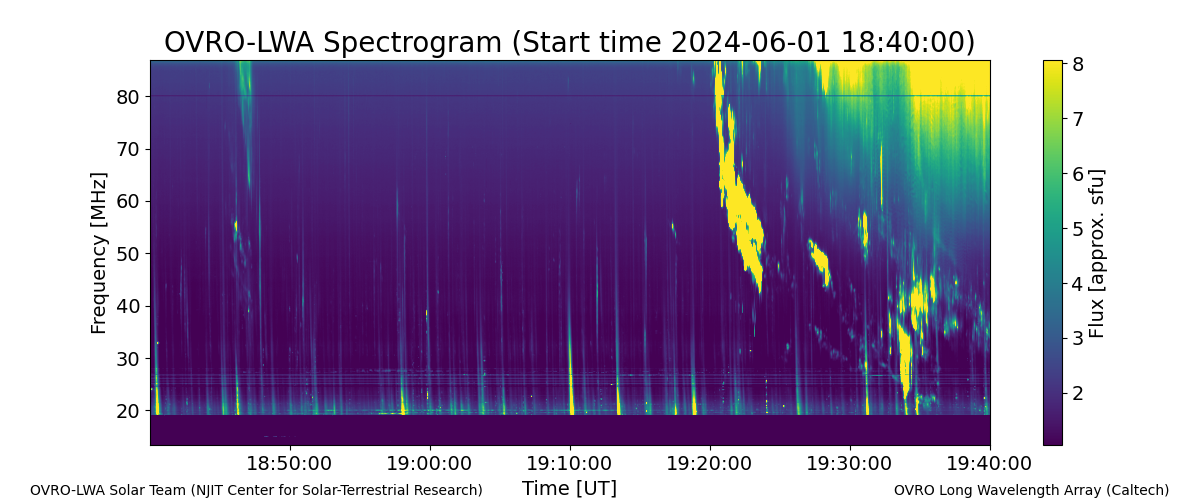
UPDATE 02 Jun at 08:30UTC - The CMEs associated with the X1-M7 flare events from 1 June turned out to be a full halo (SOHO / Lasco imagery underneath ; difference images) with a plane-of-the-sky speed of 600 km/s (CACTus). The bulk of the CME is not directed to Earth, but the CME has an earth-directed component. A preliminary arrival time late on 3 June is possible. The SIDC forecaster is now further analyzing the most recent imagery to finetune the speed of the CME, the time of arrival and the intensity of the expected geomagnetic disturbance. The intensity may be a bit higher due to the contribution of the CME associated with the M7 flare, but as it looks to deliver only a glancing blow, it is unlikely to be a severe geomagnetic storm. Meanwhile, as the sunspot group still hosts a complex delta magnetic structure, further X-class flaring from NOAA 3697 can be expected over the coming days, with an earth-directed component of the associated CME very likely. The proton flux has remained at background levels (GOES).

UPDATE 03 Jun at 08:30UTC - Further analysis by the SIDC forecaster of the CMEs associated with the X1-M7 flare events from 1 June (see clip above) indicates that "... the first full halo CME detected from 19:00 UTC June 01 in LASCO/C2 data, which was initially reported to be associated with the X1 flare, may in fact be related to a backside event and may therefore not impact Earth. A second narrower partial halo CME directed to the south-east can be seen from 20:00 UTC June 01 in LASCO/C2 data. This is likely associated with the M7.3 flare with peak time 19:39 UTC June 01 and associated with Type II and Type IV radio emissions. Preliminary analysis suggests that this CME may have an Earth directed component and may impact Earth from early on June 04, but further analysis is ongoing. ..." Meanwhile, STEREO-A's heliospheric imager (HI - see this STCE newsitem) shows something might be on route to Earth, as shown in the image underneath. Earth is to the left and outside the image. It is likely that much of this CME structure is directed off the Sun-Earth line, and that it will deliver only a glancing blow to the earth environment. At any rate, only minor to at most moderate geomagnetic storming on most likely 4 June is expected IF the CME delivers its glancing blow. The delta magnetic structure in NOAA 3697 seems to be weakening, but another strong flare from NOAA 3697 with an earth-directed CME remains possible over the next few days. The proton flux has remained at background levels (GOES).
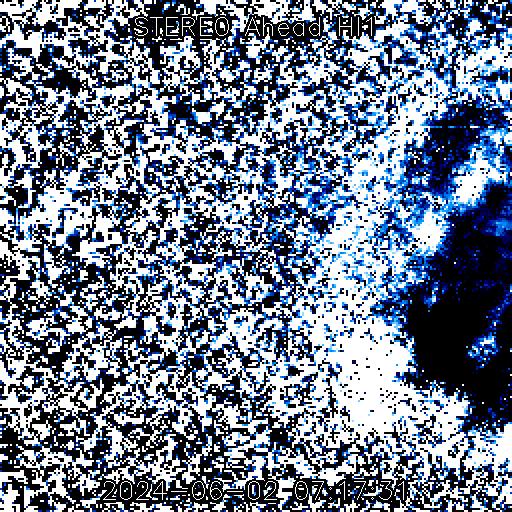
UPDATE 08 Jun at 18:00UTC - The strongest proton event so far in SC25 took place today 08 June (GOES). This is what the analysis by the SIDC forecaster revealed: "Solar flaring activity was high over the past 24 hours. The largest flare was a M9.7-flare, with peak time at 01:49 UTC on June 08, from NOAA AR 3697 (beta-gamma-delta). ... A halo Coronal Mass Ejection (CME) first appeared in the SOHO/LASCO-C2 field of view on June 08 at 01:48 UTC. The plane-of-the-sky speed of the CME was around 1000 km/s (CACTus). The CME was associated with the M9.7 flare peaking 01:49 UTC on June 08, from NOAA AR 3697 (S18W53) near the west limb. Analysis of this CME is ongoing but a glancing blow of this CME is possible in the beginning of June 10. ... The greater than 10 MeV proton flux, as measured by GOES-18, increased sharply above the 10 pfu threshold on June 08 at 02:55 UTC, and reached a maximum level of 1030 pfu at 08:00 UTC. The greater than 100 MeV proton flux, as measured by GOES-18, rose above the nominal levels and peaked at 8.3 pfu at 03:40 UTC. This proton event is associated with the M9.7 flare from NOAA AR 3697. The proton flux is expected to remain elevated over the coming days and any further flaring activity with associated proton events from NOAA AR 3697 could cause further increases. ..."
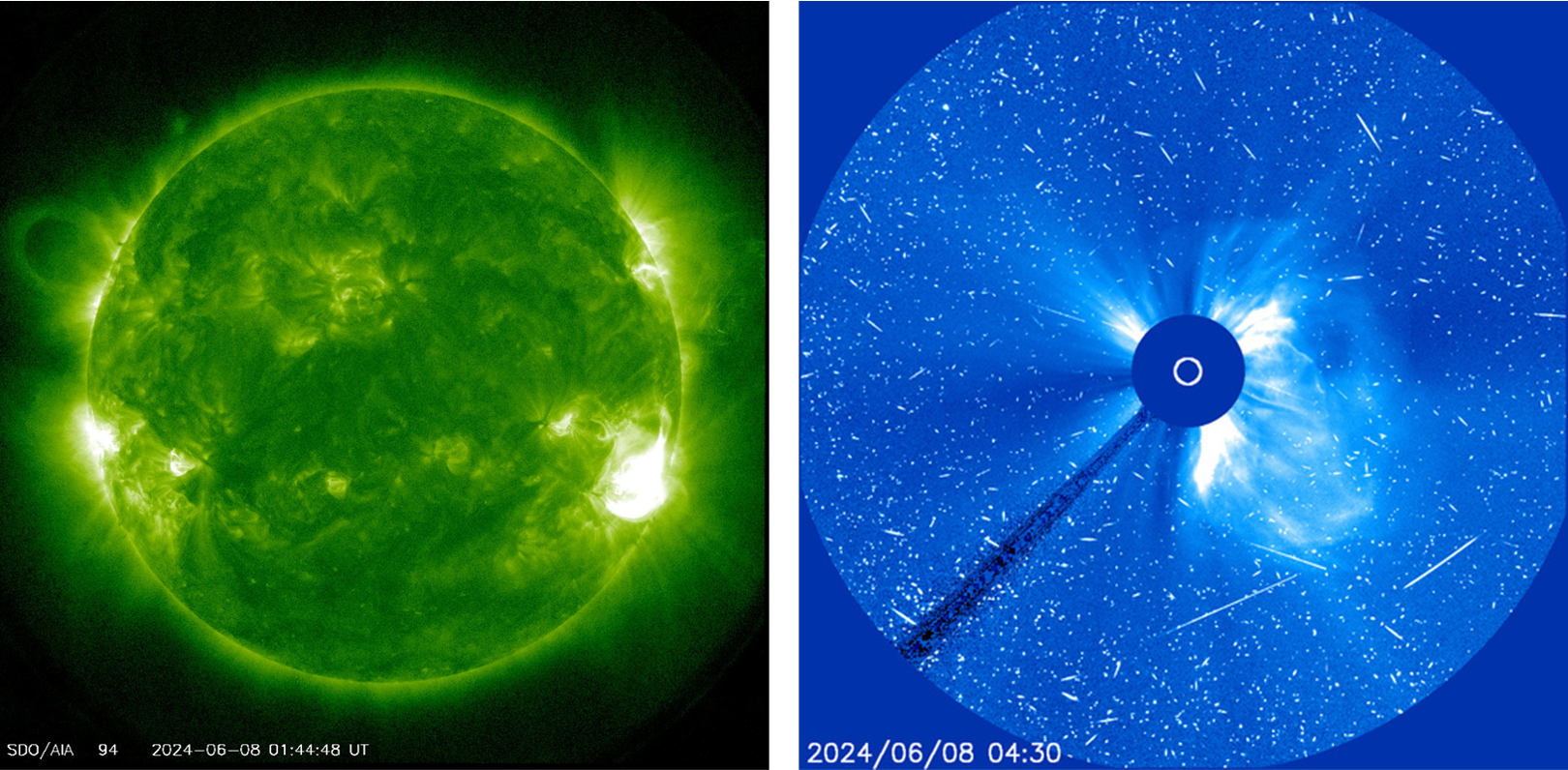
Note that this strong proton event (a brief S3 on the NOAA scale) does not seem to be associated with a Ground Level Enhancement (GLE ; see the STCE newsitems here and here) as can be deduced from the NMDB database (chart). Degraded HF radio propagation through the polar regions and navigation position errors are likely. Satellites may have experienced single-event upsets, noise in imaging systems (SOHO/LASCO: see image above), and slight reduction of efficiency in solar panels.Due to the lack of a GLE, the radiation hazard for astronauts on EVA and passengers and crew in high-flying aircraft at high latitudes should have been very mild or non-existent. As a result, the only advisories that have been sent to the civil aviation (PECASUS /SWPC) for this event were for disturbed High Frequency (HF) communications over the polar areas (latitudes > 60° ; DRAP).
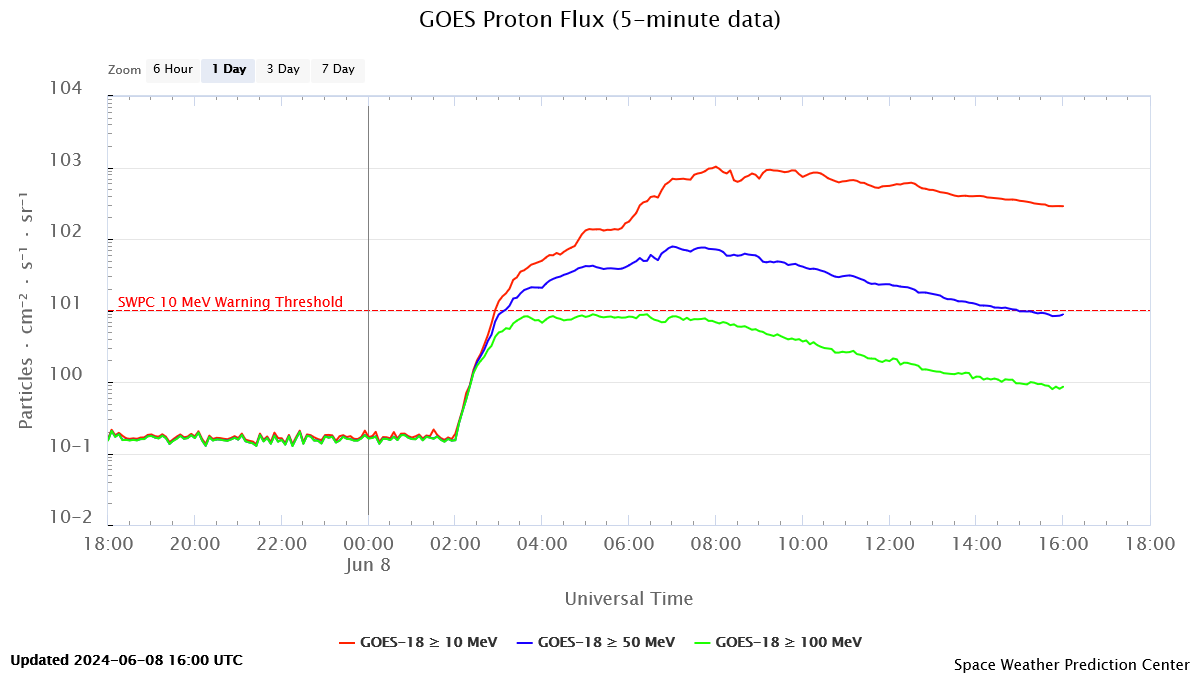
A Type II radio burst has been observed (NOAA/USAF network). A coronal wave (Solar Demon) has been observed. This almost X-class event most likely affected High Frequency (HF) communications over the western portion of the Pacific Ocean, Australia, Southeast Asia, China and Japan (DRAP). Most radio frequencies were affected by this event (Owens Valley ; spectrogram underneath). Several magnetometer stations on the daylight side of the Earth, such as in Vietnam and New-Zealand, registered a relatively strong solar flare effect (SFE) of 10-35 nT associated with this flare (Intermagnet (BGS)). An SFE happens when one or more components of the magnetic field strength show a spike around the time of the flare's peak due to ionospheric enhancement by the flare's x-ray and (E)UV radiation (also known as a "magnetic crochet").
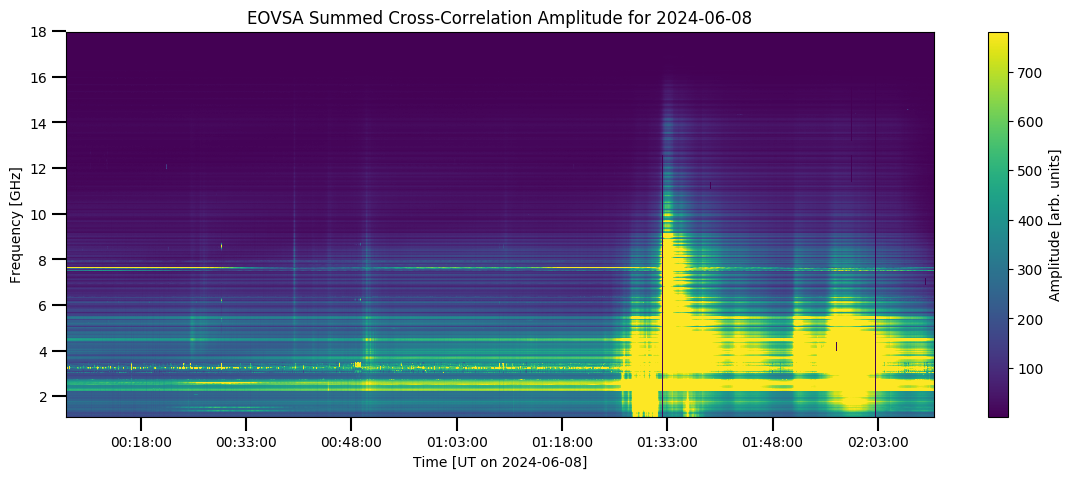
UPDATE 10 Jun at 13:15UTC - NOAA 3697 produced another X-class flare, this time a X1.5 flare peaking at 11:08 UTC on 10 June. Preliminary coronagraphic images by SOHO and STEREO-A indicate the presence of an associated CME, but without an earth-directed component. Enhancements in the proton flux levels over the next hours are possible. Further isolated X-class flares from this region are becoming less likely as the region has rotated over the Sun's southwest limb. A small solar flare effect (SFE) of a few nT was recorded by magnetometer stations on the daylit side of the Earth (Intermagnet (BGS)). High Frequency (HF) communications over Europe, Africa and the Arabian peninsula, and portions of China and West-Asia may have been affected (DRAP ; chart). Only the higher frequencies of the observed radio spectrum (4 GHz and above) were (mildly) affected by the radio emission (NOAA USAF network).
